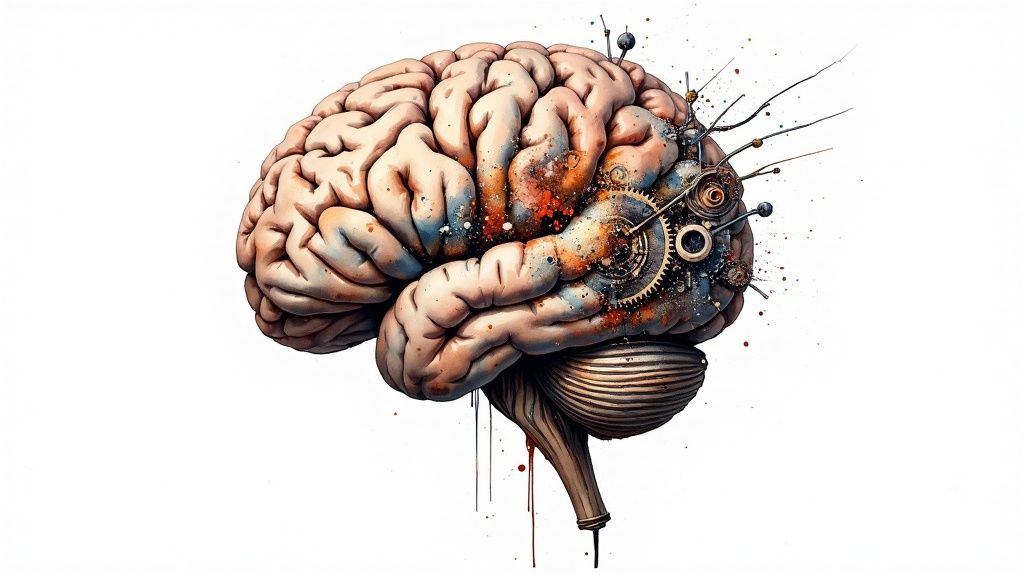10 Essential Artificial Intelligence Characteristics That Shape Our Digital Future
To truly understand artificial intelligence's potential, we need to examine its key characteristics in detail. These foundational traits shape how AI systems work in practice and determine what they can and cannot do. By understanding these core elements, we can better evaluate current AI capabilities and limitations.
Key Attributes of Intelligent Systems
At its heart, AI excels at learning and adapting through experience. Using machine learning algorithms, AI systems can improve their performance without explicit programming. Take chess AI as an example - it analyzes millions of games to develop winning strategies and continuously refines its approach. AI systems also demonstrate logic-based reasoning within their specialized domains, whether that's medical diagnosis or supply chain optimization.
Another essential capability is how AI systems process information from their environment. This includes analyzing visual data, understanding speech, and interpreting sensor readings. Self-driving cars showcase this well - they must constantly process visual information to safely navigate traffic. The ability to interact naturally is equally important. Virtual assistants use natural language processing to understand and respond to users, creating smooth conversations between humans and machines. This technology is growing rapidly - by 2024, an estimated 8.4 billion digital voice assistants will be in use worldwide.
Understanding the Limitations
While AI has made impressive progress, it faces clear constraints. Current systems often struggle with common sense reasoning and context understanding that humans find intuitive. Many AI models are also highly specialized - they excel in narrow areas but have trouble applying their knowledge to new situations. For instance, an AI that's great at identifying cats in photos might fail completely when shown a simple cat drawing or an unusual cat pose.
The heavy reliance on data presents another key limitation. Most AI systems need massive training datasets, which can be hard to obtain in many fields. This data dependency also raises concerns about bias - if an AI learns from biased data, it will likely perpetuate and amplify those same biases in its decisions.
Understanding both the capabilities and limitations of AI helps set realistic expectations for its use. As this technology continues to develop, having a clear picture of what AI can and cannot do becomes increasingly valuable for making smart implementation decisions.
The Real Impact of Computational Power

After examining AI's key limitations, we need to look at how computing power helps overcome these challenges. Processing capabilities directly affect how well AI systems can handle complex tasks, influencing everything from analysis speed to the sophistication of AI applications. As computing power grows, AI systems become more capable of handling advanced operations.
Processing Power: The Engine of AI Advancement
Take image recognition as an example. Just a few years ago, accurately identifying objects in photos required specialized hardware and considerable processing time. Today, thanks to advances in Graphics Processing Units (GPUs) and AI-specific chips, devices can recognize images almost instantly - even on smartphones. This dramatic improvement shows how better processing power expands what AI can do.
The data demands of AI systems also highlight why strong computing power matters. Training a language model requires analyzing massive amounts of text - often terabytes worth. Without robust processing capabilities, creating these complex models would be impossible. Better computing resources allow AI systems to learn from more data, leading to improved performance in tasks like understanding and generating text.
Balancing Power and Efficiency
The computing needs of AI systems do create some challenges. Large AI models use significant electricity, which affects both environmental impact and operating costs. This has sparked efforts to develop more efficient AI hardware and software. New chip designs specifically built for AI tasks show promise in delivering better performance while using less energy.
Optimizing AI Performance Within Constraints
Companies are finding practical ways to manage their computing needs. Many use cloud computing services to access powerful processing resources as needed, avoiding large hardware investments. Others focus on optimizing their AI models to work better with existing hardware through techniques like model compression, which reduces model size and complexity while maintaining accuracy. These approaches help organizations use AI effectively within their resource limits.
The growth of distributed computing also helps by allowing AI model training across multiple machines, which speeds up development significantly. This means new AI applications can be built and deployed faster. As processing power continues advancing, it keeps expanding the possibilities of what AI can achieve, though always within practical constraints that need careful management.
Making Sense of Machine Learning

Machine learning sits at the heart of modern artificial intelligence, serving as the engine that powers AI's ability to learn and improve over time. Unlike traditional software that follows fixed rules, machine learning systems can analyze data, identify patterns, and refine their performance without explicit programming. This core capability enables AI to tackle increasingly complex tasks while becoming more accurate and efficient through experience.
How AI Systems Learn and Adapt
The learning process in AI systems mirrors how humans learn from experience, but at a much larger scale. Machine learning algorithms can process millions of data points to spot subtle patterns that would be impossible for humans to detect. Take fraud detection as an example - these systems analyze countless transactions to identify suspicious patterns, learning to distinguish legitimate purchases from potential fraud with increasing accuracy. As the AI processes more examples of both normal and fraudulent activity, it continuously updates its understanding, much like a chess player who improves by studying past games and practicing new strategies.
Practical Implications of Adaptive Learning
This ability to learn and adapt is reshaping how work gets done across industries. In healthcare, machine learning helps doctors spot diseases earlier by analyzing medical images with remarkable precision - in many cases exceeding what human radiologists can achieve. Manufacturing plants use these systems to predict equipment failures before they happen, while retailers tap into machine learning to better understand shopping patterns and provide more relevant product recommendations. To learn more about putting these capabilities to work, explore our guide on How to master AI Literacy for Professionals.
Measuring and Optimizing AI Learning Performance
Success with machine learning requires careful attention to how well systems perform in real-world conditions. This means setting clear metrics - for example, tracking how often a customer service AI successfully resolves issues without human help. Testing is also crucial, with separate datasets used for training versus evaluating the system to ensure it can handle new situations it hasn't seen before. Regular monitoring helps identify where the AI needs fine-tuning to deliver better results. Through this cycle of measurement and improvement, organizations can help their AI systems become increasingly effective at solving problems and supporting better decisions.
Mastering Human-AI Communication

The way AI systems communicate with humans has become remarkably natural and fluid. Think about how easily we can now ask Siri or Alexa for help, or dictate messages on our phones. This seamless interaction comes from several key AI capabilities working together to bridge the gap between human and machine communication.
The Nuances of Natural Language Processing
At the heart of human-AI communication is Natural Language Processing (NLP), which gives machines the ability to understand and respond to human language. This goes far beyond simple word recognition - NLP systems need to grasp context, meaning, and even emotional undertones in conversation. For instance, the same word can have very different meanings depending on how it's used, requiring AI to analyze sentence structure and context for accurate interpretation.
The AI's ability to learn from experience plays a major role in effective NLP. By training on massive text datasets, AI systems discover patterns in how humans express ideas and emotions through language. Like a child learning to speak, these systems get better at communication through continued practice and feedback. Real-world interactions help refine their understanding of language nuances over time.
Building Bridges Between Humans and Machines
Good human-AI communication isn't just about machines understanding us - it's about creating interfaces that feel natural to use. Consider how much easier it is to ask a question in plain language versus typing complex search terms. This is where thoughtful interface design meets AI capability to create truly user-friendly experiences.
Yet challenges remain in achieving truly natural communication. AI still struggles with subtle aspects of human interaction like sarcasm, humor, and cultural references that rely on shared context and understanding. These limitations highlight why ongoing research is critical for improving how humans and AI systems connect and collaborate.
From Chatbots to Content Creation: Practical Applications
We're already seeing the impact of better human-AI communication across many fields. Customer service chatbots now handle basic support queries, letting human agents focus on complex issues. In healthcare, AI helps doctors quickly find key details in medical records and research. Content creators use AI tools to assist with research, editing, and early drafts.
As these communication capabilities grow more sophisticated, we'll likely see even more ways for humans and AI to work together effectively. The key is understanding both the potential and current limitations of AI communication, so we can thoughtfully develop systems that complement and enhance human capabilities rather than trying to replace them entirely.
Decision-Making in the AI Era
AI systems have fundamentally changed how organizations make strategic decisions. The shift extends far beyond basic automation - AI now tackles complex analysis and strategic planning by processing data to surface valuable insights. This new approach raises important questions about how AI makes decisions and what key traits shape its capabilities.
How AI Approaches Problem-Solving
Unlike humans who rely on intuition and experience, AI excels through systematic data processing and pattern recognition. Take a bank using AI to evaluate loan applications - the system can analyze thousands of past cases to identify key risk factors like credit scores, income, and employment that predict defaults. This leads to faster, more precise risk assessment compared to traditional methods.
AI also continuously improves its accuracy through machine learning. By reviewing past decisions and outcomes, the system refines its algorithms to make better predictions over time. However, current AI has clear limitations. It often struggles with nuanced situations requiring common sense judgment or ethical reasoning - areas that still need significant development.
Combining AI Insights with Human Expertise
The most successful approaches pair AI's analytical capabilities with human judgment. While AI excels at processing massive datasets to spot patterns, humans provide essential context, empathy, and ethical oversight. This partnership works best when organizations clearly define the roles of AI and human decision-makers. For more guidance, see How to master strategic decision-making with AI.
Medical diagnosis offers a prime example - AI can scan images to flag potential issues, but doctors use their expertise to interpret findings and make final diagnoses. This collaboration maximizes AI's analytical power while maintaining human oversight of critical choices. Setting clear guidelines for when to rely on AI versus human judgment ensures responsible implementation.
Real-World Examples of AI Decision-Making
Many industries already use AI to enhance decision-making. Supply chain teams use AI to optimize inventory, forecast demand changes, and improve logistics - reducing costs and boosting efficiency. Marketing departments leverage AI to personalize customer experiences, target campaigns more precisely, and predict consumer behavior patterns.
Navigating the Challenges and Limitations
Despite its benefits, AI decision-making faces important hurdles. Biased training data can produce unfair or discriminatory outcomes, highlighting the need for careful data preparation and algorithm development. The "black box" nature of some AI models also makes it hard to understand how they reach conclusions, raising concerns about transparency. Ongoing research and responsible implementation practices must address these limitations to build trust in AI decision-making. As the technology evolves, understanding both its strengths and constraints remains crucial for maximizing its benefits.
Future-Proofing Your AI Strategy
Understanding the core characteristics that power AI capabilities is essential for building a strategy that will stand the test of time. As AI systems take on more complex tasks, attributes like adaptability, reasoning, and information processing become increasingly important. Organizations need to grasp these fundamentals and anticipate how they'll shape future AI applications.
Adaptability and the Evolving Nature of AI
The ability to learn and adapt is one of AI's most powerful traits. Through machine learning, AI systems can improve their performance by analyzing data - without needing explicit programming updates. This becomes especially valuable as data volumes grow exponentially. For example, in healthcare, adaptive AI enables personalized treatment plans based on individual patient data. In retail, it allows dynamic pricing that responds instantly to market conditions. As AI becomes more integrated into daily life, this adaptability helps systems learn our preferences and anticipate our needs.
Reasoning and the Rise of Explainable AI
Beyond adapting, AI systems need strong reasoning capabilities to be truly useful. While current AI excels at specific tasks, it often struggles with the nuanced, contextual understanding that comes naturally to humans. However, research advances are leading to AI that can better comprehend complex situations and explain its decision-making process. This emerging field of "explainable AI" is crucial for building trust, especially in sensitive domains like healthcare and finance where transparency matters. You might be interested in: How to master AI Literacy for Management and Business Educators.
The Growing Importance of Human-AI Collaboration
As AI capabilities expand, successful collaboration between humans and AI becomes increasingly vital. Rather than replacing human workers, AI works best when it augments and enhances human abilities. For instance, AI can handle routine tasks while humans focus on creative thinking, strategy, and complex problem-solving. This partnership requires new skills - particularly critical thinking and the ability to work effectively alongside AI systems.
Preparing for the Future of AI
Taking a proactive approach is key to succeeding with AI. This means staying current with emerging trends, committing to ongoing learning, and maintaining flexibility as the technology evolves. Organizations should create environments that encourage experimentation while carefully managing potential risks. Understanding these core AI characteristics helps both individuals and companies make the most of AI's capabilities.
Ready to take your AI strategy to the next level? Explore the comprehensive AI courses and strategic consultancy services offered by Dixon Humphreys, a leading firm specializing in AI development and training. Visit https://dixonhumphreys.com to learn more and unlock the full potential of AI for your organization.

